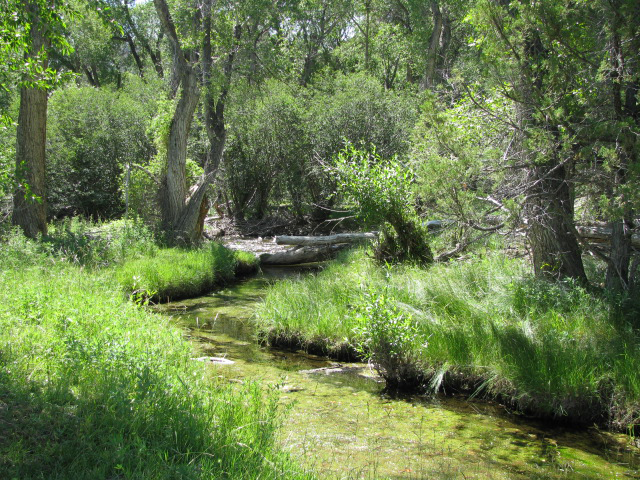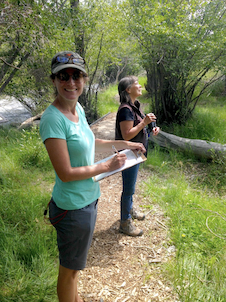Central Colorado Conservancy
Why Bird Conservation?
Past executive Director Andrew Mackie summed up the mission of the Central Colorado Conservancy (CCC) as “focusing on three things – protecting land and water, working on restoration and stewardship, and engaging people in these protection, restoration, and stewardship efforts.” They strive to accomplish this work across their six-county service area in Central Colorado. Andrew, who is an avid birder, recognized an opportunity to reach new audiences by trying to incorporate bird conservation into the land trust’s core mission. He sees the potential for bird-focused projects to have far-reaching impacts for the organization’s other goals. “If you’re protecting riparian forests for birds, you are protecting land for fish, reptiles, amphibians, large game animals, and for people so it’s an overall win for everything we do.”
Spotlight Resource: Protecting Lewis’s Woodpecker through Citizen Science
When looking for ways to incorporate bird conservation into CCC’s ongoing efforts, the Lewis’s Woodpecker was an easy choice. This species is unique to the western United States, draws a lot of attention due in part to its large size, and nests in older cottonwood riparian areas associated with water. For CCC, a high profile and easily identifiable species was the perfect candidate to use to develop a citizen-science monitoring program around their core mission of protecting land and water.

CCC capitalized on the charismatic woodpecker by placing “Have you seen me?” flyers in target areas and set out to build a volunteer base to conduct Lewis’s Woodpecker monitoring across their lands and beyond. They trained over 70 individuals interested in assisting with the surveys. The training was two tiered. In Tier 1, volunteers received information about Lewis’s Woodpecker natural history, survey protocols, and eBird. eBird is the world’s largest biodiversity-related citizen science project, with more than 100 million bird sightings contributed each year by people around the world. eBird data documents bird distribution, abundance, habitat use, and trends through checklist data, but the best part is the program includes a basic scientific framework that is already in place for land trusts to access and use for free online. In Tier 2 of CCC’s training, citizen-science volunteers received additional instruction on assessing and documenting woodpecker habitat. The program, which ran from May 2017 to April 2018, resulted in 150 Lewis’s Woodpecker sightings entered into eBird, 65 phone calls and emails from the flyer advertisements, and the participation of nearly 100 community members in trainings and presentations highlighting the program.
Making the Connection
For a land trust focused on land and water conservation, gathering information and developing tools to help identify priorities is key. Engaging new members is also at the forefront of organizational needs. For Andrew Mackie and the CCC, the benefit of this project was using a planning tool (eBird) to help make a connection between engagement and on-the-ground conservation. “I really liked this project because it was a direct connection between people and conservation action. Citizen scientists went into the field and collected data using eBird, then our organization put that data to use. We can now use this information to make decisions and talk to landowners about protecting and managing property, which is actively contributing to the conservation of a species.” Based on the success of this project, CCC has committed to making bird-focused projects a part of their long-term conservation planning efforts.
Advice to Other Land Trusts

CCC realized while developing this project that they had an opportunity not only to work toward one of their goals of preserving riparian habitat, but to engage new partners and members through birds. They accomplished this by tapping into existing public interest for birding and using free and easily accessible tools, like eBird and informative flyers, to engage community members not already familiar with the bird community as CCC does not have active Audubon chapters and local bird conservation organizations within their service area. Using a charismatic bird to engage these different groups was important as even non-birders were excited about the Lewis’s Woodpecker. “We were shocked with the response after we put up these ‘Wanted Posters’ and received a couple of phone calls a week from people who would not classify themselves as birders or even conservationists.” says Mackie. This provides a platform for continued engagement and educational opportunities, “We can reach out and ask if people want to receive updates and newsletters. We can start making connections with the charismatic woodpecker and other species using their riparian habitats. We can tap into potential volunteers and offer training sessions with fully operational programs like eBird.” Building partnerships and engaging with experts, like Cornell, to develop these tools was a critical component to the success of the project, and a stepping stone for continuing the project into the future. They also shared information, lessons learned, and their successes with other like-minded organizations and agencies to help build their capacity and garner support for their work.
Next Steps
CCC continued their project through the 2018 nesting season, offering more workshops and eBird trainings and posting their flyers in the community. They are compiling all data collected into ArcGIS to determine population centers of Lewis’s Woodpecker activity compared with parcel ownership and land use. This compilation will help them pursue active protection of identified parcels resulting in conservation for the Lewis’s Woodpecker and other species using those habitats. In the future, CCC hopes to build on the partnerships established through this project to help them dive deeper into the science to identify why Lewis’s Woodpecker populations are declining overall.
Conservation Action Update!
Two conservation projects are moving forward, in part, due to nesting Lewis’s Woodpecker populations on the properties. One project is a 500-acre ranch in Chaffee County where the ranch owners became interested in the Lewis’s Woodpecker project and are now working with the Conservancy to place a conservation easement on the property.
Note: The Central Colorado Conservancy was a recipient of a 2017 Land Trust Small Grant award.


